Your search for 'locks'
returned
1,449 results.
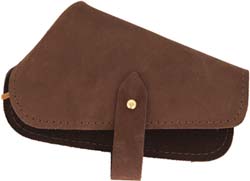
|
Leather Lock Cover , for 6-3/4" by 3-1/2" lock
These lock covers are made of thick chocolate brown leather, and cover a lock 6-3/4" wide, by 3-1/2" tall. The cover is secured to the stock with a 7/8" wide strap and brass knob. A must-have item for your rifle or fowler.
|

|
Tumbler , wax cast steel, drilled and tempered, for L&R RPL-01 Maslin lock, RPL-02 Hawken lock, RPL-04 Tennessee
Tumbler , wax cast steel, drilled and tempered, for L&R RPL-01 Maslin lock, RPL-02 Hawken lock, RPL-04 Tennessee
|

|
Lock plate, percussion , wax cast steel, drilled and tapped, for L&R RPL-05 percussion Lyman Great Plains, Cabela's, or InvestArm Hawken lock
Lock plate, percussion , wax cast steel, drilled and tapped, for L&R RPL-05 percussion Lyman Great Plains, Cabela's, or InvestArm Hawken lock.
|

|
John Bailes , right hand flint lock, by L&R
Sometimes called a small Manton, baby Durs Egg, or small English flint lock. This smaller lock is a fine London design, in the style of John Bailes, gunmaker. Correctly used on English pistols, rifles and dainty fowlers of the 1770-1810 period. After about 1780 this improved style of lock is found on American guns, having been smuggled here from En
|
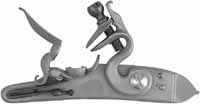
|
John Bailes left hand, flint lock, by L&R
Sometimes called a small Manton, baby Durs Egg, or small English flint lock. This smaller lock is a fine London design, in the style of John Bailes, gunmaker. Correctly used on English pistols, rifles and dainty fowlers of the 1770-1810 period. After about 1780 this improved style of lock is found on American guns, having been smuggled here from En
|

|
John Bailes - London left Percussion Conversion Lock, by L&R
John Bailes - London left Percussion Conversion Lock This left hand John Bailes cap lock exactly matches our right hand John Bailes cap lock. Each can be made to interchange with our right and left hand John Bailes flint locks. Fine original flint locks were converted to percussion, during the 1825 to 1880 period. The flash hole was replaced wit
|

|
Siler large right Flint Lock, by Jim Chambers
Siler large right Flint Lock One of the first correct flint locks made for scratch builders, Siler’s flint lock is our most popular. Now made in matching right hand percussion and left hand flint and percussion, for sets and doubles! This lock is modeled after a fine hand made original lock by the famous American gunmaker, Jacob Dickert. Few oth
|

|
Siler small right Flint Lock, by Jim Chambers
Siler small right Flint Lock One of the first small flint locks made for scratch builders, Siler’s flint lock is our most popular. This lock is modeled after a fine hand made original lock by the famous American gunmaker, Jacob Dickert. Few other American gunmakers made their own locks. He may have made and sold locks to others. We have examined
|

|
English Durs Egg - London right Flint Lock, by L&R
Durs Egg - London right Flint Lock Perhaps London's most innovative lock and gun maker, Mr. Durs Egg immigrated from Switzerland, setting up shop in London, the world's arms making center in his time. Actually, “Durs" was a nickname, but Mr. Egg adopted it as his own. We are glad he did. Once you have used this lock, you will never confuse the “
|
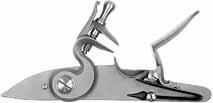
|
Early Ketland Flint Lock, by Jim Chambers
Early Ketland Flint Lock This flat faced English flint lock is made in the style of the early work of Thomas Ketland, for use on traditional American longrifles and English fowling guns of the 1750-1780 era. Unmarked, you might engrave KETLAND in block letters ahead of the cock, as many old locks were marked. A few locks also had simple floral
|
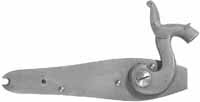
|
Lock, Back Action right hand, percussion, by L&R
Called “back action” because the mainspring hangs behind the tumbler, this lock was popular on percussion guns made in St. Louis, New York, California, Ohio, England and Belgium. Swivel breech double rifles require a back action lock mechanism. This lock can be modified for flint use. Side-by-side or over-and-under double rifles, shotguns, and comb
|
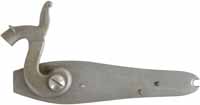
|
Lock, Back Action left hand, percussion, by L&R
Called “back action” because the mainspring hangs behind the tumbler, this lock was popular on percussion guns made in St. Louis, New York, California, Ohio, England and Belgium. Swivel breech double rifles require a back action lock mechanism. This lock can be modified for flint use. Side-by-side or over-and-under double rifles, shotguns, and comb
|
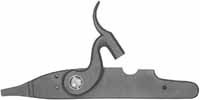
|
Bedford County right hand, percussion lock, by L&R
Studying the longrifles of Bedford County, Pennsylvania, might cause you to imagine that time nearly stopped in Bedford County, or that this region was isolated from the world. How can we explain why these men continued to make Bedford County rifles for over 120 years, much later than we might expect? How can we explain these very odd locks, with l
|

|
Siler large left Flint Lock, by Jim Chambers
One of the first correct flint locks made for scratch builders, Siler’s flint lock is our most popular. Now made in matching right hand percussion and left hand flint and percussion, for sets and doubles! This lock is modeled after a fine hand made original lock by the famous American gunmaker, Jacob Dickert. Few other American gunmakers made their
|
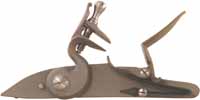
|
Early Ketland Flint Lock, with pan bridle, by Jim Chambers
Early Ketland Flint Lock This flat faced English flint lock is made in the style of the early work of Thomas Ketland, for use on traditional American longrifles and English fowling guns of the 1750-1780 era. Unmarked, you might engrave KETLAND in block letters ahead of the cock, as many old locks were marked. A few locks also had simple floral
|

|
Flint Lock , French Tulle Fusil de Chasse , with A. TVLLE marking
Tulle, France was well known for producing the popular hunting gun for trade to American and Canadian natives, French Colonials, and hunters during the early 18th century in the North American Colony of New France. These fusil de chasse were lighter and handier than contemporary French infantry muskets, making it better suited for traveling long di
|